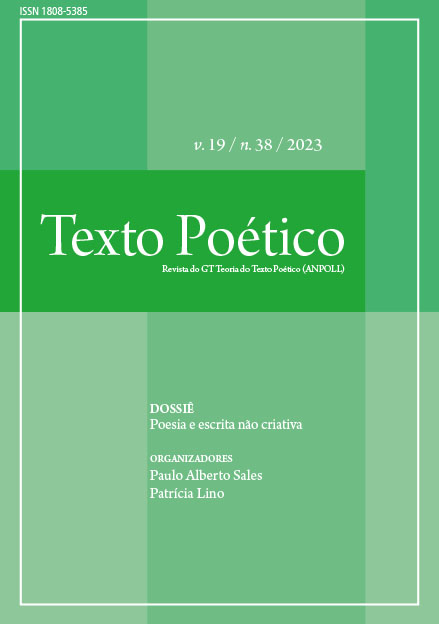Poetry-generator bots in Twitter: tradition and innovation
DOI:
https://doi.org/10.25094/rtp.2023n38a928Keywords:
Twitter, Poetry, Bots, Versification, Semantic coherenceAbstract
In this article, we have analyzed bots’ generative poetry from Twitter, an electronic literature genre that uses programming for poetic compositions and belongs to the field of twitterature. We discussed characteristics of this genre and analyzed two accounts: “Jane Austen Haiku” (@JaneAustenHaiku) and Auto Imagist Bot (@AutoImagist). We focused on the boundaries between human/ machine in the artistic construction, how programming dictates the writing and each project’s aesthetical choices, either focusing on formal aspects, or aiming at semantic coherence. Our results show that, even though these productions use digital resources and tools, there remains a latent connection with print literary tradition.
References
ACIMAN, Alexander; RENSIN, Emmet. Twitterature: The World’s Greatest Books Retold Through Twitter. Londres: Penguin, 2009.
ATHAYDE, Manaíra; ROCHA, Rejane Cristina. A circulação da literatura no mundo on-line: os casos de Clarice Lispector e de Caio Fernando Abreu. Estudos
de Literatura Brasileira Contemporânea, n.59, p.1-25, 2020. Disponível em: https://cutt.ly/dQtujTy Acesso em: 26 jul. 2021.
AUTO IMAGIST BOT. Generating imagist-style poetry by combining random picture descriptions, powered by Microsoft Azure. A bot by @zachwhalen, #botALLY. Twitter: @AutoImagist [Bio]. 2017. Disponível em: https://twitter.com/AutoImagist. Acesso em: 1 ago. 2022.
AUTO IMAGIST BOT. a / body / of / water / inside / of / a / flower. 4 ago. 2022a. Twitter: @AutoImagist. Disponível em: https://twitter.com/AutoImagist/status/1555351178602594305. Acesso em: 7 ago. 2022.
AUTO IMAGIST BOT. a small boat in a large body / of water alongside / a tree / with a mountain in the / background. 05 ago. 2022b. Twitter: @AutoImagist. Disponível em: https://twitter.com/AutoImagist/status/1555532375664254992. Acesso em: 7 ago. 2022.
AUTO IMAGIST BOT. a cat wit / h its mou / th open u / p against / a flower. 5 ago. 2022c. Twitter: @AutoImagist. Disponível em: https://twitter.com/AutoImagist/status/1555623011310608386. Acesso em: 7 ago. 2022.
BOLTER, Jay David; GRUSIN, Richard. Remediation: Understanding New Media. Cambridge: MIT, 2000.
CEIA, Carlos. Imagismo. In: CEIA, Carlos (org.) E-Dicionário de termos literários. 2009. Disponível em: http://www.edtl.com.pt. Acesso em: 15 jul. 2022.
CUDDON, John Anthony Bowden. Haiku. Dictionary of Literary Terms and Literary Theory. London: Penguin Books, 1999.
FLICKR. Tags – Mais populares de todos os tempos. Flickr. 2022. Disponível em: https://www.flickr.com/photos/tags. Acesso em: 15 jul. 2022.
FLORES, Leonardo. Third Generation Electronic Literature. Electronic Book Review, 7 abr. 2019. Disponível em: https://doi.org/10.7273/axyj-3574 Acesso em: 15 jul. 2022.
FLORES, Leonardo. Artistic and Literary Bots. In: O’SULLIVAN, James (org). Electronic Literature as Digital Humanities: Contexts, Forms, & Practices. New York: Bloomsbury Academic, 2021. p.131-143.
GARRAMUÑO, Flora. Frutos estranhos: sobre a inespecificidade na estética contemporânea. Rio de Janeiro: Rocco, 2014.
GOLDSMITH, Kenneth. Uncreative Writing. New York: Columbia University, 2011.
HAYLES, Katherine N. Literatura eletrônica: novos horizontes para o literário. São Paulo: Global, 2009.
JANE AUSTEN HAIKU. Bot that tweets random haiku assembled from Emma, Pride and Prejudice, and Sense and Sensibility. Tweets every hour. By @amarriner. Twitter: @JaneAustenHaiku [Bio]. 2014. Disponível em: https://twitter.com/JaneAustenHaiku Acesso em: 1 ago. 2022.
JANE AUSTEN HAIKU. So much the better / What is before me i see / I ought to travel #Haiku. 15 nov. 2020a. Twitter: @JaneAustenHaiku. Disponível em: https://twitter.com/JaneAustenHaiku/status/1327989826600263682 Acesso em: 1 ago. 2022.
JANE AUSTEN HAIKU. It cannot last long / The night was cold and stormy / They then went away / #Haiku.15 nov. 2020b. Twitter: @JaneAustenHaiku. Disponível em: https://twitter.com/JaneAustenHaiku/status/1327717981674217475 Acesso em: 1 ago. 2022.
JANE AUSTEN HAIKU. Do the children grow/ She had no objection/ It would never do #Haiku. 15 nov. 2020c. Twitter: @JaneAustenHaiku. Disponível em: https://twitter.com/JaneAustenHaiku/status/1327869000173359104 Acesso em: 1 ago. 2022.
JANE AUSTEN HAIKU. You will excuse me / Elinor is well you see / And a special licence / #Haiku. 15 nov. 2020d. Twitter: @JaneAustenHaiku. Disponível em: https://twitter.com/JaneAustenHaiku/status/1327929396997599232 Acesso em: 1 ago. 2022.
JANE AUSTEN HAIKU. No more is emma / But i always thought i should / There is jealousy / #Haiku. 15 nov. 2020e. Twitter: @JaneAustenHaiku. Disponível em: https://twitter.com/JaneAustenHaiku/status/1327899196964429824 Acesso em: 1 ago. 2022.
JENKINS, Henry. Cultura da convergência. São Paulo: Aleph, 2009.
MANOVICH, Lev. Novas mídias como tecnologia e ideia: dez definições. In: LEÃO, Lucia (org.). O chip e o caleidoscópio: reflexões sobre as novas mídias. São Paulo: SENAC, 2005.
MENEZES, Vera. A linguagem dos emojis. Trabalhos em Linguística Aplicada, Campinas, n. 55, v. 2, p. 379-399, maio/ago. 2016.
MONTIEL, Daniel Escandell. Tuiteratura: la frontera de la microliteratura en el espacio digital. Iberical, Université Paris-Sorbonne, n. 5, p. 37-48, 2014. Disponível em: https://e-space.mmu.ac.uk/620980/ Acesso em: 15 mar. 2021.
NOWVISKIE, Bethany. Algorithm. In: RYAN, Marie-Laure; EMERSON, Lori; ROBERTSON, Benjamin J. (org.). The Johns Hopkins Guide to Digital Media. Baltimore: Johns Hopkins University Press, 2014. p. 16-19.
PAZ, Octavio. O arco e a lira. Rio de Janeiro: Nova Fronteira, 1982.
RECUERO, Raquel. Redes sociais na internet. Porto Alegre: Editora Sulina, 2009.
RETTBERG, Scott. Collaborative Narrative. In: RYAN, Marie-Laure; EMERSON, Lori; ROBERTSON, Benjamin J. (org.). The Johns Hopkins Guide to Digital Media. Baltimore: Johns Hopkins University Press, 2014. p. 78-80.
Downloads
Published
How to Cite
Issue
Section
License
I authorize the Texto Poético Journal to publish the paper of my authorship/responsibility that I now submit, in case it is accepted for online publication.
Moreover, I declare that this contribution is original and that it was not submitted to any other editor for publication.
The copyright of the works published at the virtual space of the Texto Poético Journal are automatically entitled to the journal. Their total or partial reproduction is conditioned to the authors' citations and publication data.

Texto Poético is licensed under a Creative Commons - Attribution-NonCommercial 4.0 International (CC BY-NC 4.0).









